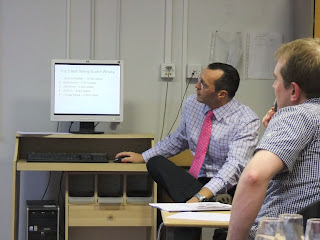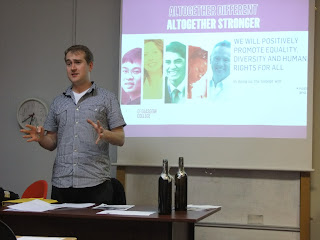







I am tutoring the Advanced Whisky course at the City of Glasgow College at the moment. This week, the students had to present for 5 minutes on a whisky-related subject of their own selection. All the students' presentations showed very good levels of research into their subjects.
Alan Hall (who for some reason on Tuesday, I was calling Peter - must have been a senior moment or three) presented on Customs Officer Malcolm Gillespie. His presentation was entertaining and contained lots of detail, some specifics of which I hadn't come across before.
Ian Petrie presented on Advertising. He did a critique of half a dozen ads from magazines. His outcome of this was that, with the exception of Jack Daniels, they didn't hit their target audience of 20-35 years old. It's true that the JD ad was the only one which wasn't the "glass & bottle" style, but I felt that the Glenfiddich ad has moved away from it quite considerably.
Steve Richardson presented on Abhainn Dearg, the new distillery on Lewis. He had produced a Powerpoint slideshow with a lot of detail and included some historical facts of illicit distillation in the Outer Isles.
Bob Arnott also had a Powerpoint show, this time on the relative merits of Dunnage Warehousing versus Racking. It was a thoughtful presentation and pushed the oft-quoted reason of cost versus quality, but laid the question, "but should cost be the deciding factor?" and suggested that to mature whisky in large, central warehouses and not at the distillery, while not breaking the rules, was breaking the spirit of the regulations.
Jim Coleman posed the question: “Are Whisky Bloggers Important to the Industry?” As a whisky blogger, Jim may be biased, but he argued that most bloggers have no direct affiliation to any whisky company and so they are de facto independent. As such, they help to “spread the good word” and encourage enjoyment in all forms.
James Farrelly also posed a question. This time it was “Does Scotch Whisky Have a Future?” James had obviously done a lot of digging to obtain the statistics he argued with and his conclusion was that, “yes, it does have a future, but that it needs some generic advertising.”
Stefan Kah’s subject was German Whisky and he looked in detail at the many German whisky distilleries, most of which had developed out of fruit spirits distillation. He demonstrated their uniqueness and differences from the general acceptance of “what is a whisky” by sampling the products of two small distilleries including a smoky Steiger Wald which was coarse, rough and out of balance. He advised that most were very small, amateur producers and could not understand why Jim Murray’s Whisky Bible 2011 had scored all of the German Whiskies he had tasted in excess of 90 points.
Jeff McKenzie caused us to look at “What Do We Expect From a Whisky?” His presentation was thought provoking and fitted in well following on from Stefan’s. He suggested that we all look for Scotch look-alikes and argued that each country should develop their own style of whisky.
Gary Ledgerwood’s subject was Prohibition. He looked at the fact that, during Prohibition, whisky was available as a medicine, the routes into the States, and shortcuts for the production of bathtub whisky. His conclusion was that the industry had “played it right” and that the fact that they had continued to supply U.S. distributors (whether legal or not) had served them well since then.
Jim Schultz argued that “Proof = Bravado & Rent”. He argued that high alcoholic strength (proof) = bravado as it makes us less inhibited and thus braver to say and do what we would have been reticent to say or do when sober. He argued that proof makes our kidneys work harder and that the alcohol is in our bodies for a short period of time and therefore proof = rent. Amusing and different.
All in all a very good demonstration of their understanding of the subject and good to note that there was no overlap, in that every student had selected a completely different subject. As a tutor, when setting a project for a number of students, I regularly expect that there will be a couple who will select the same or similar topics. This time, all different.
Naturally, there was ablind tasting after their challenges: Aberlour 10, Bowmore 12, Glenlivet 18 and Glenlivet 12 - in that order to confuse them. They all got the order correct and identified the regions and James Farrelly correctly identified Glenlivet 18.
No comments:
Post a Comment